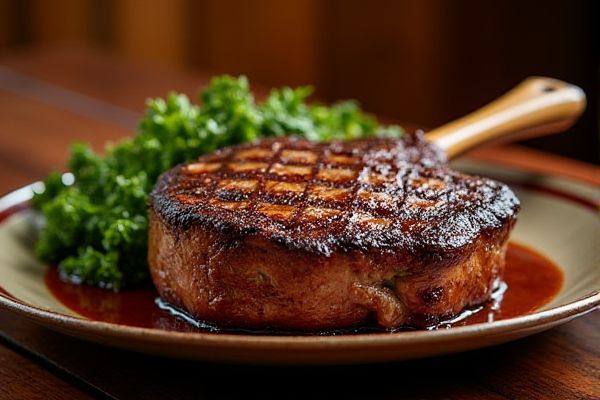
Prime Bone-In Ribeye from Fleming's Prime Steakhouse features a juicy, marbled ribeye steak cooked to perfection with a flavorful bone-in cut, delivering a tender, savory experience complemented by a caramelized crust and rich, beefy aroma.
Equipments
- Grill or broiler
- Tongs
- Meat thermometer
- Cast iron skillet
- Basting brush
- Chef’s knife
- Cutting board
- Plate or serving platter
- Aluminum foil
Ingredients
- 2 lb (900g) prime bone-in ribeye steak
- Kosher salt
- Freshly ground black pepper
- 2 tablespoons olive oil
- 2 tablespoons unsalted butter
- 2 cloves garlic
- 2 sprigs fresh rosemary
- 2 sprigs fresh thyme
When preparing your 2 lb prime bone-in ribeye steak, ensure it is well-marbled to achieve the tender and juicy texture characteristic of Fleming's Prime Steakhouse. Use kosher salt and freshly ground black pepper generously to enhance the beef's natural flavors. Fresh herbs like rosemary and thyme added during cooking infuse the steak with aromatic notes that elevate its savory profile. Use a meat thermometer to reach the perfect internal temperature, avoiding overcooking that can compromise tenderness. Your Prime Bone-In Ribeye copycat menu will capture the essence of Fleming's signature steakhouse experience with careful attention to ingredient quality and cooking technique.
Instructions
- Instructions:
- Remove ribeye steak from the refrigerator and let it come to room temperature (about 30–45 minutes).
- Pat the steak dry with paper towels.
- Generously season both sides with kosher salt and freshly ground black pepper.
- Preheat grill, broiler, or cast iron skillet to high heat.
- Brush steak lightly with olive oil.
- Sear steak for 2–3 minutes per side to create a caramelized crust.
- Reduce heat to medium and continue grilling or transfer skillet to preheated oven (if using).
- Add butter, crushed garlic cloves, rosemary, and thyme to the skillet or next to steak if on grill.
- Baste steak with melted butter and herbs using a basting brush or spoon.
- Cook until steak reaches desired doneness (130°F/54°C for medium rare), checking with meat thermometer.
- Transfer steak to cutting board and loosely tent with aluminum foil.
- Rest steak for 10 minutes before slicing.
- Slice against the grain with a chef’s knife and serve on a plate or serving platter.
Substitution
Prime Bone-In Ribeye from Fleming's Prime Steakhouse copycat menu calls for a premium cut that emphasizes marbling and bone-in flavor. If you can't find a bone-in ribeye, a boneless ribeye or New York strip can be used as alternatives, but expect a slightly different texture and flavor profile. When grilling or broiling, monitor the internal temperature closely with a meat thermometer to avoid overcooking, especially if the steak is thinner than usual. Use a cast iron skillet to sear the steak if outdoor grilling is not possible, as it helps develop a caramelized crust. Your final presentation benefits from resting the steak under aluminum foil to retain juices for a tender and flavorful bite.
Tips
Allowing your ribeye to reach room temperature before cooking ensures even doneness and better flavor absorption. Patting the steak dry is crucial to achieve a perfect caramelized crust when searing. Use a meat thermometer to avoid overcooking; medium-rare is reached at 130degF (54degC). Resting the steak under foil for 10 minutes helps redistribute juices for a tender, juicy bite when you slice against the grain.
Nutritions
A prime bone-in ribeye steak from Fleming's Prime Steakhouse is rich in high-quality protein essential for muscle repair and growth. This cut contains substantial amounts of iron, zinc, and B vitamins, which support energy metabolism and immune function. The marbling of fat provides a source of healthy monounsaturated fats, while the cooking process with olive oil and butter enhances flavor without significantly adding unhealthy fats. Your meal is not only flavorful but also nutrient-dense, making it a satisfying choice for a balanced diet.
Storage
Store your prime bone-in ribeye steak in an airtight container or tightly wrapped in plastic wrap, then place it in the refrigerator at or below 40degF (4degC) to maintain freshness for up to 3-5 days. For longer storage, wrap the steak tightly in aluminum foil or freezer paper and freeze at 0degF (-18degC), where it can retain quality for up to 6-12 months. Always thaw frozen steak in the refrigerator overnight to preserve texture and flavor before cooking.
Variation or Alternatives
For a variation, swap fresh rosemary and thyme with smoked paprika and cumin to impart a smoky, slightly spicy flavor to the ribeye. You can also experiment by dry-aging the steak in your refrigerator for 3-5 days to enhance tenderness and intensify its beefy aroma. Instead of searing in a cast iron skillet, try finishing the steak sous vide at 129degF (54degC) for 1-2 hours before giving it a quick high-heat sear for an evenly cooked, juicy result. If you want a richer taste, replace olive oil with clarified butter or beef tallow when brushing the steak.
Allergies
Prime Bone-In Ribeye contains dairy from unsalted butter, which may trigger allergic reactions in individuals with milk allergies or lactose intolerance. The seasoning with kosher salt and black pepper is generally safe, but cross-contamination in preparation areas could pose risks for those with severe allergies. Your awareness of these ingredients ensures safe consumption and helps avoid unexpected allergic responses.
Why this recipe?
Prime Bone-In Ribeye from Fleming's Prime Steakhouse boasts rich marbling that delivers an exceptional balance of juiciness and robust beef flavor, making it a favorite among steak enthusiasts. The expertly aged and hand-cut steak offers a tender texture that melts in your mouth, elevating the dining experience. Trying to recreate this dish at home allows You to indulge in a gourmet-quality steak with personalized seasoning and cooking techniques, ensuring a delicious, restaurant-style meal. The combination of premium quality beef and meticulous preparation highlights why this menu item is worth attempting to replicate.
